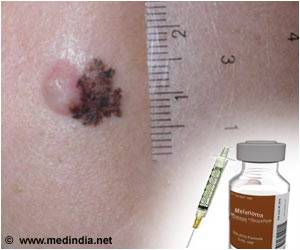Curcumin like synthetic compound was used to identify genes associated with melanoma progression, as curcumin displayed anti-tumor action in earlier studies.
Highlights
- DM-1, synthetic compound similar to that of curcumin have now identified genes associated with progressive melanoma
- Melanoma is the rarest and the most lethal form of skin cancer, it mainly develops from the cells that produce melanin called melanocytes
- Non-chemoresistant parent melanoma cells, when treated with DM-1 compound showed drug-induced cell death and reduction in tumor volume
As Oliveira explained, there are hundreds of papers attesting to the anti-oxidant, anti-tumoral, anti-microbial and anti-inflammatory properties of curcumin in the scientific literature. However, the therapeutic usefulness of this compound in its natural form is limited owing to poor absorption, rapid metabolization, and water insolubility. To solve this problem, scientists have developed synthetic analogues with minor structural modifications to make the molecule more stable in the organism.
DM-1 (sodium 4-[5-(4-hydroxy-3-methoxyphenyl)-3-oxo-penta-1,4-dienyl]-2-methoxy-phenolate) was synthesized some years ago by José Agustín Pablo Quincoces Suárez, a professor at Bandeirantes University (UNIBAN).
"Experiments with animals conducted by collaborators showed that treatment with DM-1 could promote a reduction in tumor volume. DM-1 has also proved toxic to chemoresistant melanoma cells," Oliveira said.
Mechanism of action of DM-1 synthetic compound
"This yeast’s genome has 6,000 genes, and a different gene has been knocked out in each of these mutants, so we were able to study the effects of the compound in a highly specific manner, gene by gene," Oliveira said.
The next step was to filter the genes in order to identify those with homologues in the human genome since some might be associated with functions specific to yeast. The researchers came up with a second list containing 79 candidate genes, thanks to the aid from bioinformatics tools and the expertise of Helder Nakaya , another fellow researcher and also a professor at FCF-USP.
"We then began to look at public repositories of genomic data from cancer patients, such as The Cancer Genome Atlas (TCGA ) and the Gene Expression Omnibus (GEO), to understand how these genes talked to each other," Oliveira said.
The analysis showed most to be associated with cell signaling pathways that favored tumor progression when active. Examples included the pathways mediated by mitogen-activated protein (MAP) kinase and epidermal growth factor receptor (EGFR).
The next step was to investigate which genes were important to the progression of melanoma specifically. This entailed using bioinformatics to focus on the analysis of genomic sequences from melanoma patients.
"We performed a data mining exercise to find genes with altered expression during melanoma progression," Oliveira said. "We identified seven genes that appeared to be important, and when we looked at the public databases, we could see that the expression of these genes was indeed altered in many patients."
In vitro tests with non-chemo resistant parent melanoma cells showed that treatment with DM-1 induced cell death, mainly because it increased expression of a gene known as TOP-1. When this gene is active, it leads to DNA transcription errors and hence causes genomic instability in cells.
In chemo resistant melanoma cells, cyto-toxicity was caused mainly by increased expression of the gene ADK, which is involved in energy production for cells.
"Like curcumin, which can interact with multiple cellular targets and modulate multiple signaling pathways, DM-also acts in different ways to promote toxicity in both parent and drug-resistant melanoma cells," Oliveira said.
Further research on genes associated with melanoma progression
In a second postdoctoral project now in progress with FAPESP’s support, Oliveira is more deeply investigating the participation in melanoma progression of TOP-1 and of another gene called ATP6V0B, one of the seven identified in the previous project.
"We want to find out how these genes are expressed in a broad panel of melanomas - primary, metastatic, with and without mutation in the BRAF gene, drug-resistant or non-resistant - and to compare these findings with their expression in normal melanocytes. The point is how these genes participate in tumor progression and what happens in each case when they’re inhibited," she said.
Although melanoma is the rarest form of skin cancer (approximately 4% of cases), it is undoubtedly the most lethal. It develops from melanocytes, the cells that produce melanin. In addition to rapid growth and the potential to become highly invasive and metastatic, this type of tumor frequently becomes resistant to the main drugs used for treatment.
"Today, the existence of different cell sub populations within the same tumor is considered the main factor associated with resistance to treatment," Oliveira said. "For this reason, the best approach is believed to consist of a combination of several therapeutic strategies, so the discovery of new targets is important."
Reference
- Érica Aparecida deOliveira, Diogenes Saulo deLima, Lucas EstevesCardo et.al. Toxicogenomic and bioinformatics platforms to identify key molecular mechanisms of a curcumin-analogue DM-1 toxicity in melanoma cells, Pharmacological Research (2017).https://doi.org/10.1016/j.phrs.2017.08.018
Source-Eurekalert













